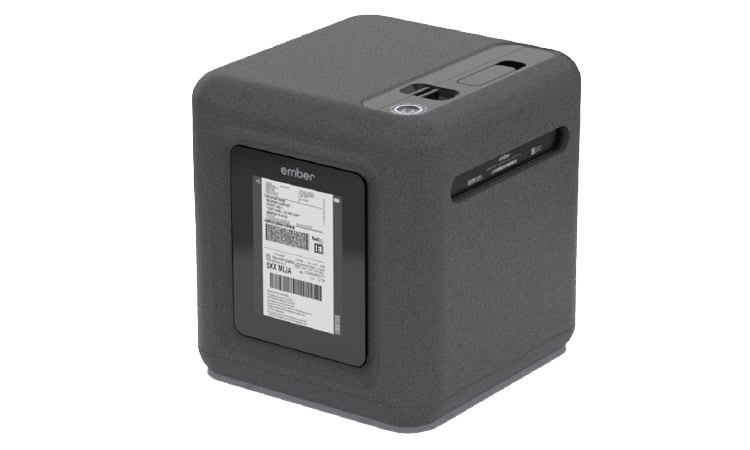Top Healthcare Logistics Trends and Other Supply Chain News

New cold chain technology for blood-sample shipping; six health care supply chain trends to watch; and other updates in healthcare logistics.
Cold Chain Tech Glows
Ember LifeSciences and the U.S. Anti-Doping Agency (USADA) have partnered to enhance the efficiency of blood-sample shipping processes for upcoming sporting events, including the 2024 U.S. Olympic Team Trials.
Ember LifeSciences’ cold chain technology focuses on self-contained, self-monitoring shipping systems for items such as temperature-sensitive pharmaceuticals, vaccines, and lab specimens. The Ember Cube (photo above) provides a fully integrated solution to common and costly challenges in cold chain shipping. Its design addresses issues related to tracking and temperature-sensitive deliveries, ensuring secure transport and preserved efficacy of medicine and specimens.
The USADA used the Ember Cube at several sporting events in 2023, including the Boston and New York Marathons and the Ironman World Championship in Kailua-Kona, Hawaii.
Through these events, hundreds of blood samples from elite athletes were transported in Ember Cubes to drug testing labs across the United States. Leveraging Ember’s cloud-based dashboard, USADA was able to monitor the real-time location, ambient temperature, and payload temperature of the Cubes during transit, ensuring that the blood samples maintained optimal temperatures and chain of custody was retained throughout the journey.
Beyond addressing shipment delays, the Ember Cube presented USADA with a cost-effective, integrated shipping solution given its reusability and advanced features, including self-refrigeration capabilities to store collected blood samples before and during transport. The Cube’s integrated temperature monitoring also eliminated the need for a standalone temperature logger, enhancing the overall efficiency, simplicity, and reliability of the process.
6 Healthcare Supply Chain Trends to Monitor
It will take next-level healthcare supply chain management to deliver next-level healthcare, according to DHL’s latest whitepaper, Delivering Next-Level Healthcare, which identifies these six key trends driving healthcare logistics.
1. Patient-centric healthcare. Today’s personalized treatments require closer links between pharmaceutical manufacturers and patients. And patients now expect the same choice and convenience in healthcare as in the commercial marketplace, driving growth in the consumer healthcare segment.
2. Advanced therapies. New approaches supplant simpler, more generalized medicines. For example, complex cell and gene therapies are developed in small batches that require tightly controlled two-way supply chains. Biopharma products need to be handled carefully at every stage in the supply chain, prompting robust investments in cold chain logistics.
3. Digital healthcare. The pandemic fueled an explosion in remote healthcare, including “decentralized clinical trials” where shipments of urgent, sensitive, and temperature-controlled medications replace the movement of patients. This results in more complex healthcare supply chain management, with sophisticated sensor and asset-tracking technologies for cross-system visibility and auto-replenishment. It also has applications for blockchain technologies to guard against counterfeiting and data theft.
4. New ecosystems. The urgency with which the COVID-19 vaccines were developed and distributed reset expectations, not just for the pharmaceutical industry but for logistics as well. Accelerated timelines have led some large healthcare providers to turn to outsourced logistics providers to handle the critical flows of medicines and devices throughout the supply chain.
5. Sustainable solutions. Carbon-neutral warehousing, alternative fuels, closed-loop returnable packaging and container systems, and optimized inventory and delivery models can ensure high levels of availability while minimizing waste and helping the industry meet its emissions goals.
6. Resilience. The pandemic and its after effects brought unprecedented stress to global healthcare supply chains. The desire to avoid future disruptions has led to a “great supply chain rethink,” including more localized supply chains for essential healthcare products and insourcing of critical pharmaceuticals, active ingredients, and medical supplies.
RFID: Hospitals Tag Along
The global RFID market is experiencing significant growth and is projected to reach $40.9 billion by 2032, up from $15.8 billion in 2023, according to Markets and Markets research. Applying RFID technology to healthcare is expected to grow at the second-highest rate during the forecast period, the research finds.
Patient monitoring within hospitals presents ample opportunities to integrate RFID solutions. These technologies offer a means to track and accurately identify patients, which enhances safety protocols. By leveraging RFID-enabled patient monitoring solutions, hospitals can optimize patient flow and throughput, streamlining routing workflows while reducing medication errors.
These systems also facilitate the monitoring of patient movement history and activity levels, ensuring comprehensive room-level patient visibility. Additionally, RFID technology can detect instances of patients falling from beds or wheelchairs. Real-time monitoring capabilities afforded by RFID solutions offer a proactive approach to preventing such incidents.
“The demand for temperature-controlled shipments, especially for vaccines, is on a steady rise. This trend, coupled with the fact that most healthcare-related items also require temperature control, could potentially lead to a squeeze in the availability of services. It’s crucial to anticipate these challenges and ensure we are prepared to meet the growing demand.”
—Joel Pinsky,
President,
Customized Logistics and
Delivery Association and
CEO and CFO,
Global Messenger and Logistics

At-Home Tests Not Going Away
Over the past few years, in large part due to COVID-19, healthcare providers have become more comfortable with patients self-administering tests and reporting the outcomes. As a result, the market now offers more intelligent, technology-forward devices for general consumers proactively taking charge of their own healthcare.
As healthcare and medical device companies continue to navigate this booming market, they’re also running into a host of issues: regulatory compliance, risk mitigation, quality assurance, logistics and distribution, inventory management, and typical global supply chain disruptions.
In the life sciences space, regulatory compliance is critical to guaranteeing that at-home testing kits and medical devices safely get to consumers. Companies are subject to strict mandates imposed by health authorities across the globe.
The challenges that at-home testing kits and medical devices face in supply chains aren’t going away, and are likely to get only more nuanced. It’s vital that providers work with partners that have experience in medical device logistics to help mitigate risk and successfully navigate this rapidly evolving market.
– John Marrow, President, RRD Supply Chain Solutions
